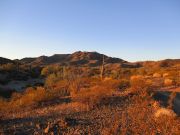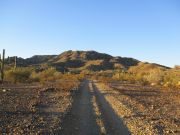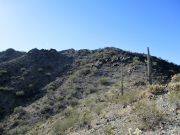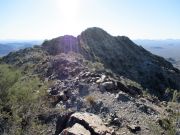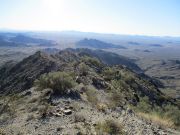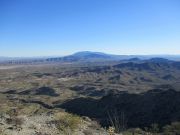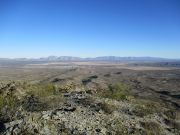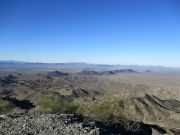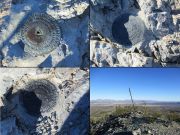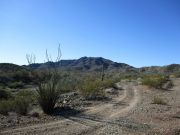
The Mountains of Arizona
• www.surgent.net
|
| Harquar Benchmark |
• Highpoint: Little Harquahala Mountains • Bureau of Land Management • La Paz County |
|
Date: December 29, 2018
• Elevation: 3,084 feet
• Prominence: 1,124 feet
• Distance: 4 miles
• Time: 2 hours and 45 minutes
• Gain: 1,120 feet
• Conditions: Clear skies, very cold
Arizona
•
Main
•
AZ P1K
•
PB
•
LoJ
•
USGS BM Datasheet
Harquar Benchmark is the highest peak of the Little Harquahala Mountains, which lie between Salome Highway and Interstate-10, south of the town of Salome. The range has been heavily mined, with a couple active operations still in place. Hundreds of old mine shafts and prospects can be found here. The peak itself lies about five miles south of Salome. Some old mine tracks get about halfway up the mountain, but none go to the very top.
I left home about 6 a.m., still dark, and drove Interstate-10 west to the Salome Road exit, then followed Salome Road into Salome, a total distance of about 95 miles from home. The sun was barely rising as I rolled into Salome. I then followed Harquahala Road (called Harquahala Mine Road on the maps) south toward the range. The road is paved in town, then turns into hardpack. The road bends southeast, then back southwest. I found a smaller road on my right (west) that parallelled an arroyo. This road is shown on the topographical map and is northeast of the peak. I was able to drive in about an eighth of a mile, parking in a clearing before the road dropped into the arroyo.
The day was clear but very cold. The sun was still low in the sky, and the air temperature, going by the car's temperature gauge, was in the mid 30s. However, it was not uncomfortable. There was no breeze whatsoever. I walked the area a little bit to see where the roads went, then got my stuff together and started walking at 8 a.m. sharp.
I followed the road down into the arroyo, then up a bank and back onto the desert flat, the road bending more south for now, then west, aiming for a low saddle north of the mountain. I was soon north of the mountain's main mass. I then followed another road south into a small pocket hemmed into by two ridges, all this shown accurately on the map and on satellite images. The road itself was in pretty good shape, but the arroyo part at the start would pose a challenge for most vehicles. An ATV would be fine.
The ridge to my immediate right looked most friendly, so I started up its slopes and soon found a good-looking trail, which was unexpected. I followed the trail upwards, now on the main ridge itself. From here to the top, I had about 800 vertical feet to gain. The ridge looked good the whole way up, with rock outcrops every hundred feet.
I just picked my way south up this ridge. The trail was helpful but not necessary now. It would disappear in the rocks, then re-appear. All it did was tell me someone else was here before me. I gained up a steep segment and found myself on top of a small peaklet, shown as a tiny 3,000-foot contour on the map. From here, I had my first good view of the summit, about an eighth of a mile away. The summit lies atop a rocky crown.
This last section went well but was a little rockier. Soon, I was below the last rocky slope below the top. I walked up a series of rock steps, short chutes and open rock to get onto the top, arriving at 9:30 a.m.. I had to use hands but I would not rate any part of this more than Class-2.
I spent about 15 minutes up top looking around and taking photos. The benchmark and its two witness markers are all here, mostly unscratched and still readable. The register went back to 1989, where Bob Martin had signed in. The last person before me was here in February, but not many people had been here, the register showing about one or two groups a year, some years with no one. Most were the usual peakbagger names, and a few were Salome locals.
For the downhill hike, I retraced my route exactly, and in about 45 minutes was off the ridges and back onto the roads. In another half-hour, I was back to my car, arriving a little before 11 a.m.. The hike had gone well with no navigation problems, no cliffs or barriers to slow me, and helped by that meager trail. The day had stayed cold. The car's temperature gauge had the outside temperature still in the mid 40s.
I drove out by following Harquahala Mine Road south through the range. The road is smooth and any vehicle could drive it. About eight miles later, I was at Interstate-10 at the Hovatter Exit. I got on the freeway and drove straight home.
|
|
